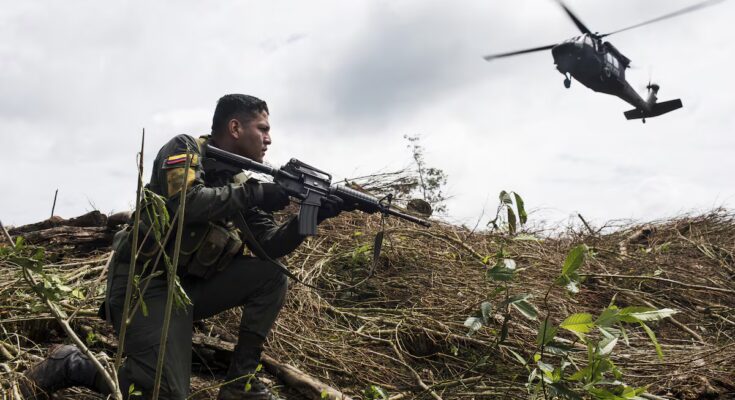The death of at least seven minors due to a bombing by the Military Forces in the town of Itilla, in the municipality of Calamar, in Guaviare, forced President Gustavo Petro to give explanations and return to the past, when he was a senator. In 2019, in the midst of a military bombing by Ivan Duque’s government in Caquetá, in which seven minors also died, and which cost the head of the then Minister of Defense, the then MP Petro trill: “If the government knew that there were minors before the attack in Caquetá, we would be faced with a war crime, that is, a crime against humanity.” Six years later, the current president claims he was unaware of the presence of minors. But not knowing that there were minors conflicts with the numerous evidence that exists on the recruitment of boys and girls by the Central General Staff (EMC) led by Ivan Mordisco in the Colombian Amazon. These are figures that demonstrate that the risk of minors dying in a bombing by this group was not only predictable, but high.
Before the ombudsman’s office confirmed the ages of some of the deceased on Saturday, Petro and his defense minister, Pedro Sanchez, had already admitted the likelihood that minors were among them, especially since they knew that three had been rescued after the attack. Two days before the ombudsman’s statement, Petro said at a police ceremony that bombings “always have a risk” and that “without adequate knowledge of the area and if intelligence fails, they can fall on minors, and this is the big risk that only the president takes.” Then, trill that this case was different from Duque’s bombing because “we did not hide the information”, “the information was not complete and carried risks” and because, according to him, if they had not bombed, “150 well-armed men could have killed 20 soldiers who were at the front”. In his latest explanation, he stated that “in Mordisco’s columns there were only fighters and we did not know of the presence of minors”.
The evidence contradicts them. Although both the EMC and the Calarcá dissidents have been recruiting children for years, since January 2025, when their clash in Guaviare openly began, there are several indications that Mordisco is bringing minors from other regions of the country to reinforce his troops. That month, during a clash between the two dissidents in the village of Miravalle, in the municipality of Calamar – the same where the attack took place – 16 people died, including six minors, all from the Mordisco area. Some of these minors came from Cauca, where the commander of the Western Bloc Jacobo Arenas operates, who has influence in the south-west of the country, is part of the EMC, and for months has been supporting the Amazonas Bloc of Mordisco not only with weapons, but also by sending people from that department and from Nariño to Meta and Guaviare, including minors, as is also evident in the case of a 14-year-old girl who had been recruited by his men to reinforce their units in Meta, and that you were rescued in November last year on the Bogotá-Villavicencio highway.
The minors do not only come from Guaviare del Cauca or Nariño, but also from regions such as the Amazon. A high-level military source in the Amazon told this newspaper that this year alone he is aware of at least 15 cases of minors leaving from La Pedrera, Amazonas, and being taken along the Apaporis River to Guaviare for training in the ranks of Mordisco. In fact, Caren Smith Cubillos Mirana, a 13-year-old girl who died in this bombing, grew up in La Pedrera. The other four minors about whom we have information so far were born in Arauca, Norte de Santander, Guaviare and Putumayo.
The Ombudsman’s Office had also previously warned against this EMC strategy of bringing minors from other regions in an early warning issued in January. “In the south of the Meta department, for its part, after the operations carried out by the Army, it became publicly evident that dissidents under the command of ‘Iván Mordisco’ recruited children and adolescents (children and adolescents) from Cauca,” reads the alert. “Many of the victims of this conduct are adolescents (girls). Although many of the operations took place in Mesetas (where there are clashes between the two dissidents), it is highly likely that these dynamics are present in all the high-risk areas of this department, Caquetá and Guaviare where warlike actions between the parties can take place.” But he goes further, warning: “The speed with which recruited children and adolescents are trained and immediately subjected to combat increases the chances that they will be killed or seriously injured in combat.” Furthermore, on June 2 this year, in response to the announcement of an armed strike by the EMC in Guaviare, which forced hundreds of people to lock themselves in their homes, he explicitly said: “There are missing people, minors recruited and murdered, and today more than 10,000 people are confined due to the clashes between the dissidents led by alias Ivan Mordisco and those led by alias Calarcá.”
Data from the Colombian Institute for Family Welfare (ICBF) is further evidence of recruitment in Guaviare. While there is generally under-recording in this area, while in 2024 the ICBF recorded only two cases of children and adolescents separated from armed groups in that department, in 2025 there were 21 cases. Of these 21, eight were in Calamar, the same municipality where the attack took place. In fact, in April of this year, the same Army recovered two minors, aged 16 and 17, right there, in Calamar.
According to the president, if they had not bombed 150 well-armed guerrillas, they could have killed 20 men from the Joint Special Operations Command. In the press conference held last Tuesday by the Minister of Defense, Pedro Sanchez, accompanied by military leaders, the commander of the Military Forces, Francisco Cubides, provided more details. He did not speak of 150 guerrillas, but of 120. And he said that “the soldiers of our Army fought against two structures, that of Armando Ríos, under the command of the criminal pseudonym jimmyand that of Martín Villa, alias Fish“EL PAÍS learned from a source that one of Pescado’s missions was to send troops to Arauca, including minors.
Cubides also underlines that “these two criminal structures sought to clash with structures of the GAOR faction, Calarcá, all with the aim of contesting the mobility corridors through which the illegal economy moves”. Then, according to Cubides, “in the early hours of Monday the 10th, faced with an imminent attack by these facilities against our soldiers and with the aim of protecting them, the aerospace force was invited to carry out a close air support mission, a bombing maneuver.” “It was a special forces operation against a high-value target and 150 people gathered in the bandits’ reaction,” another Amazonian military source who did not want to be quoted told EL PAÍS.
That is, men from two fronts were together in the same place with the intention of first attacking Calarcá and then attacking the 20 men of the Joint Special Operations Command (CCOES). The probability that there were minors among 120 or 150 armed men could not be low, especially in light of all the evidence of recruitment in the area. Furthermore, this was a planned operation involving extensive intelligence activity. In the press conference with Minister Sánchez, they said that 30 intelligence and criminal investigation agents participated in his execution, who “worked for more than 530 days permanently and there they developed 12,000 operational intelligence reports and had to draw up 25 operational tactics reports to establish precise positions.” With all that intelligence, plus existing public information, it was foreseeable that minors might be involved.
Beyond that, it is not even clear why these 20 CCOES men were facing such a military disadvantage, when since July this year, given the escalation of the conflict in the area, the government has announced the deployment of 1,100 soldiers to Guaviare who are part of Rapid Deployment Force Ten (FUDRA 10). According to the announcement, the soldiers would arrive in two phases: 700 soldiers in the first month and another 400 by the end of the year. In October, the same army announced the arrival of 240 men to reinforce the Joaquín París infantry battalion, which covers part of the Guaviare.
However, EL PAÍS learned from two military sources in the Amazon that this bombing was carried out by those 20 men from the CCOES with the aim of “protecting the operation” and according to the principle of information compartmentalization, which means that the less people know, the more the operational mission is protected and possible information leaks are avoided. According to this version, therefore, the bombing would not have been carried out by the troops present in the area and therefore none of the military reinforcements sent to the region would have intervened.
“Could other modes of military operation have been used that could achieve the same military advantage with significantly less damage?” defender Iris Marin asked. Even without all the details about this operation, there are other ways to react if the idea was to find a high-value target, such as a high-precision shooter, which allows you to shoot a target from a long distance, or it required an additional landing of special forces to support the 20 men on the ground.
The “high value targets” of this bombing were alias Jimmy, leader of the 44th Front, and alias Pescado, leader of Martín Villa. Both ran away.



